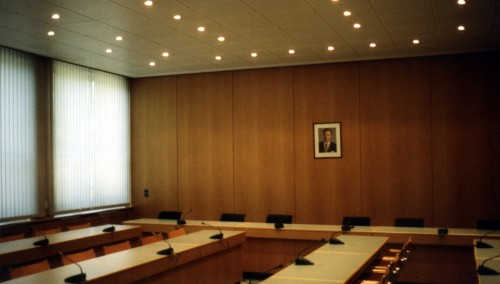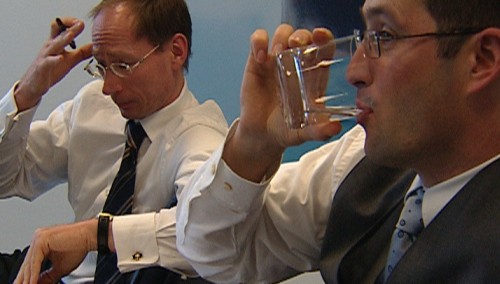Working Worlds 2005
No one goes to the cinema to see films about work! Although there is a grain of truth in this statement, it is not entirely accurate. When work can no longer be taken for granted and becomes a scarce good, this raises questions about the self-understanding of a society. Films about work have a tradition that reaches back to the beginning of documentary cinema: one of the earliest films by the Lumière brothers did not show exotic customs or anything magical, but simply workers leaving a factory. What happens, though, when the “factory” no longer exists as a functioning social space, as a “place of work”? What is there to be filmed, if work itself is becoming more and more abstract, the mechanisms by which economies function more and more invisible, intangible and invulnerable at the same time? This break from the ordered, rigid conditions of the industrial age to the flexible conditions subject to constant change of the information age has been described by the philosopher Gilles Deleuze with an image from the animal world: “The undulations of a snake are much more complicated than the tunnels of a mole.”
“Invisible Opponents”, the second “Working Worlds” Special from Crossing Europe and Kinoreal, starts at the point where our last program stopped. Whereas the life plans of young people in the New Economy was the focal point last year, this year we turn our attention to the “empty center”, around which public debates (about neoliberalism, globalization, the politics of location or extending working hours) revolve – the question of how economy “is made”, which ethics, which behaviors and attitudes set the processes in motion and keep them running.
The title of the series, “Invisible Opponents”, is borrowed from Valie Export’s film of the same title. In 1973 this film from the perspective of the Actionist and video artist identified the uneasiness towards repressive postwar society. “Uneasiness” is also the apprehension that predominates in the films that we present in this Special. The cause of this may be found in the crisis of representability that befalls documentary work in light of the immateriality of working processes. Making “invisible opponents” visible then becomes the real challenge.
How do I penetrate into the central areas of work, for instance, if there no longer seems to be a difference between autonomy and command? Which approach does one take, if modern management aims to anchor the “command”, as Maurizio Lazzarato writes, “in the subject and in communication”? Harun Farocki’s most recent video NICHT OHNE RISIKO (“Not without Risk”) chooses a veritably classic point of departure to make the abstract concept of venture capital communicable: he seeks out a negotiation, the site of communication, and carries out the business of transaction in the gesture of an impartial observer. The details of the enterprise are relatively secondary, because the arrangement has an archetypal form: a small company attempts to convince an investor that it is worthy of credit. The situation specifies the dramaturgy. Rhetorical detours are part of the deal. Ultimately, though, it is the openness of the situation, the direct interplay of both parties, which enables deeper insights into an economic practice. NICHT OHNE RISIKO works like a game, the rules of which first become clear as one watches.
Gerhard Friedl’s HAT WOLFF VON AMERONGEN KONKURSDELIKTE BEGANGEN? (“Did Wolff von Amerongen Commit Bankruptcy Offenses?”) starts from a contrary presupposition. Here the representability of complex economic processes is under suspicion to begin with. A sonorous voice-over develops a series of reports, shapes private and business deals of business tycoons from German post-war history into a (only seemingly ordered) collection of interlocking anecdotes: takeovers, tax offenses and other criminal intrigues are mentioned, but also the little foibles and inclinations of the individual persons. What becomes visible from all of this, however, is nothing: in longer tracks and pans the images probe public places in European cities, factory halls and production sites or even bank foyers. Sound and image form an illusionary unity. There are correspondences between both, but they remain arbitrary: Friedl arranges them like false clues that the viewer naturally follows in an attempt to make sense of it all.
The problem of representability may also be a reason why the “grand narrative” of the New Economy of the nineties is still lacking today. Hence WELTMARKTFÜHRER. DIE GESCHICHTE DES TAN SIEKMANN (“World Market Leader. The Story of Tan Siekmann”) is also more of a morning-after than a success story. In his documentary, the German filmmaker Klaus Stern tells the story of a technology entrepreneur, whose meteoric rise at the zenith of the Internet hype ended as a million-dollar flop. What is left to Tan Siekmann, the computer nerd, castle owner and passionate “aviator”, is the (hardly successful) new start of his company. At the same time, the film uses archive material and conversations with protagonists of the stockmarket boom of the nineties to take a critical look at a time that now seems equally ridiculous and disturbing with its faith in get-rich-quick. WELTMARKTFÜHRER subtly refers to the gray area between accidental mishap and intentional deceit whenever a “certain measure of criminal energy” is mentioned.
So what is (visible) here, are mostly only the effects. The “opponents” remain off camera. As a partner film to Gerhard Friedl‘s spiral-like speculation, we begin the show with a historical work. Egon Humer’s POSTADRESSE: 2640 SCHLÖGLMÜHL (“Mailing Address: 2640 Schlöglmühl”, 1990) is, no less than WELTMARKTFÜHRER or WOLFF VON AMERONGEN, a “rubble film” that makes the material effects of abstract global processes tangible in a strictly local context (using the example of a town in Lower Austria). And this is to be taken literally: what the camera is able to capture are worn faces and empty, decaying architectures that are set in the picture and explored again and again in long, observing shots.
Going to the cinema to see films about work today means following the tracks of the snake to anticipate its next undulation.



